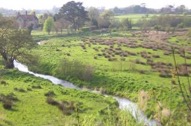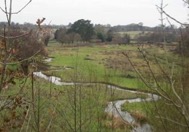The EU Water Framework Directive (WFD) advocates for the protection and restoration of rivers, lakes, groundwater bodies and riverine wetlands. There is a demonstrable impact of the WFD in terms of water quality improvement in Europe, mainly at a local scale.This case study of the River Glaven in the UK demonstrates improvements in the ecological conditions thanks to local restoration measures. It also illustrates that to improve water quality at water body scale, more actions are needed; including larger-scale river restoration measures and a catchment-based approach to reduce pressures and to have an impact on the entire water body. Moreover, an expansion of the monitoring is needed to detect improvements in adjacent wetlands and better reflect on the effects of restoration measures.
The River Glaven has historically been modified for industrial purposes and to protect the adjacent floodplain farmland. Water control structures such as weirs and sluices, together with canalisation and embankments have left the River Glaven severely modified. The connectivity between the river and its floodplain has been reduced further in the 1970s to the 1980s through dredging of the channel and draining of the floodplain. In order to reach the EU Water Framework Directive objective of “good ecological status”, river restoration measures are needed. This case study elaborates on the chosen restoration measures, the short term results and the gained insights.
Restoration measures were considered that improved the form of the river and connectivity to the floodplain. Restoration at the severely modified and disconnected Hunworth Meadows took place in 2 phases: during the first phase in 2009, around 400 m of embankments were removed resulting in a 40–80 m wide floodplain area (3 hectares). A second phase of work was conducted in 2010 to improve the river morphology. The intervention created a narrower and geomorphologically more diverse and meandering channel, with an associated increase of river sinuosity by 16%.


Re‐meandered reach of the River Glaven at Hunworth: In January 2009, prior to the rehabilitation project, on the left, and in December 2010, after re‐creation of meanders on the right[1].
Embankment removal and re-meandering alongside the River Glaven at Hunworth had positive effects for the river–floodplain ecosystem functioning. Short term results included:
- A significant increase in macrophytes’s richness;
- Limited impact on stream invertebrate biodiversity;
- A significant increase of invertebrate biodiversity in backwaters along the floodplain[2];
- An increase of the density and biomass of brown trout (Salmo trutta), but no significant short-term impact on other fish populations[3];
- A moderate but detectable effect on flood peak attenuation, owing to the limited length of restoration[4], and improved free drainage into the river.
A significant aspect of this project is the inclusion of 6 backwaters in the monitoring plan that allow a more appropriate and detailed evaluation of the ecological conditions of the whole river corridor. This is very often not the case, as sampling sites are generally located along the main channel, and side channels and backwaters are not considered within the sampling protocol[5].
Another shortcoming in most restoration projects is the solely monitoring of Biological Quality Elements (BQEs) to define the ecological status of rivers. Recent studies showed that although the BQE-based metrics and indices are sensitive to water quality alteration and general habitat degradation, their response to hydromorphological degradation is generally weak or absent[6]. The monitoring plan of the River Glaven included additional bioindicators such as dragonflies and amphibians, through which the hydromorphological impact might be better understood[7].
This case study demonstrates positive results in the improvement of the ecological conditions of the restored river reaches. This case study also points out that an implementation gap still remains between current restoration measures and the actions required to improve ecological conditions at water body scale. To achieve the WFD objectives we need interventions of a larger scale to make a difference for the “good ecological status” of the water body. Furthermore, numerous studies have shown that localised river restoration does not necessarily translate into significant improvements in biodiversity[8]. One factor that is not addressed by reach‐scale rehabilitation is the influence of catchment‐scale pressures on rivers. To have positive outcomes for bioindicators, site-based measures should be combined with addressing pressures upstream. An integrated catchment approach should be thus applied.
These insights should help water managers develop more effective restoration measures and monitoring tools. The River Glaven case study is part of a larger case study report with more examples of river restoration measures and their contribution to WFD objectives.
- [1]Champkin et al., 2018
- [2]Sayer 2014
- [3]Champkin et al., 2018
- [4]Clilverd et al., 2016
- [5]Golfieri et al., 2018
- [6]Hering et al., 2006; Friberg et al., 2009; Marzin et al., 2012; Dahm et al., 2013
- [7]Munné et al., 2003; Jähnig et al., 2009; Gumiero et al., 2015, Sayer, 2014; Simaika and Samways, 2009
- [8]Palmer et al., 2010
Header image © Jordan-Whitt

